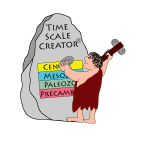TimeScale Creator
We strive to provide detailed global and regional “reference” scales of Earth history. Such scales summarize our current consensus on the inter-calibration of events, their relationships to international divisions of geologic time and their estimated numerical ages. The current database suite encompasses 59,000 datalines; in ca. 480 columns that are grouped into ca. 200 directories/subdirectories. These include major biologic, geomagnetic, sea-level, stable isotope, and other events, plus Lunar and Martian chronostratigraphy, impact events, global reconstruction images, etc.. The numerical ages of all events are dynamically computed by specified inter-calibration or proportional relationships and specified values for age-control points (e.g., stage boundary or magnetic chron age assignments of Geologic Time Scale 2020).
The internal database contains over 200 stratigraphic columns (datum suites, zones, polarity patterns, coastal on-lap and geochemical curves, etc.) grouped in a thematic menu.
Download a full listing of the columns with selected major sources and references: TSC8.0_InternalDatapack_Contents_GTS2020 10Jan2021.pdf.
Many of these datasets have been contributed by contributors to Geologic TimeScale 2020 and specialists in the various subcommissions of the International Commission on Stratigraphy (ICS). We invite users to recommend enhancements and revisions; and other suites to add.
The database includes the following main “directories”:
1. Standard Chronostratigraphy -- Divisions of International Geologic Scale (era-period-epoch-stages through Precambrian, plus sub-stages for Mesozoic) and Boundary stratotypes (GSSPs).
2. Planetary (geologic intervals for Moon, Mars, Mercury)
3. Regional Stages (N.Amer., Eurasia, Australia, etc.)
4. Geomagnetic polarity zones (Phanerozoic).
5. Main Mesozoic-Paleozoic Macrofossil Groups (ammonoids, conodonts, graptolites, trilobites) depending on period
6. Other Marine Macrofossils (belemnites, bivalves, brachiopods, ostracodes, etc.)
7. Microfossils (zones with first/last appearance datums of planktonic and benthic foraminifers, calcareous nannofossils, dinoflagellate cysts, radiolarians, diatoms, etc.)
8. Plants (spores, pollen and flora)
9. Vertebrates (fish, reptiles, mammals). Download our vertebrate evolution and tree-of-life datapacks for dinosaurs and other general types.
10. Hominid evolution and tool cultures
11. Sequences, Sealevels (major trends and sequences by different authors, schematic coastal onlaps in meters)
12. Stable Isotopes (Oxygen-18, Carbon-13 and Strontium ratios) 13. Global reconstructions (by Ron Blakey)
13. Global Reconstructions
14. Quaternary (regional stages, high-resolution ice core data, Chinese loess, Milankovitch cycle curves)
15. Global geologic history (impacts, large igneous provinces, carbonate trends, hydrocarbon systems, etc.)

